Enhanced TDS
Identification & Functionality
- Chemical Family
- RTU Product Type
- Technologies
- Product Families
Features & Benefits
- Ready-to-Use Product Features
- Product Properties
- Grey paste
- High temperature resistance
- Very resistant to water and to a wide variety of chemicals
- Gap filling, non sagging up to 5mm thickness
Applications & Uses
- Application Area
- Application Method
- Compatible Substrates & Surfaces
- Markets
- Applications
- Processing Information
Pretreatment
- The strength and durability of a bonded joint are dependant on proper treatment of the surfaces to be bonded.
- At the very least, joint surfaces should be cleaned with a good degreasing agent such as acetone, alcohol or other proprietary degreasing agents in order to remove all traces of oil, grease and dirt.
- Low grade alcohol, gasoline (petrol) or paint thinners should never be used.
- The strongest and most durable joints are obtained by either mechanically abrading or chemically etching (“pickling”) the degreased surfaces.
- Abrading should be followed by a second degreasing treatment.
- Application of Adhesive
- The resin/hardener mix may be applied manually or robotically to the pretreated and dry joint surfaces.
- Huntsman's technical support group can assist the user in the selection of an suitable application method as well as suggest a variety of reputable companies that manufacture and service adhesive dispensing equipment.
- A layer of adhesive 0.05 to 0.10 mm thick will normally impart the greatest lap shear strength to the joint.
- Huntsman stresses that proper adhesive joint design is also critical for a durable bond.
- The joint components should be assembled and secured in a fixed position as soon as the adhesive has been applied.
Properties
- Physical Form
- Notes
** For the maximum continuous operating temperature, we consider the maximum temperature for which the residual lap shear strength is 1/3 of the lap shear strength at room temperature or the temperature for which the residual lap shear strength is 5 MPa.
Regulatory & Compliance
- Certifications & Compliance
- Quality Standards
Technical Details & Test Data
- Equipment Maintenance
- All tools should be cleaned with hot water and soap before adhesives residues have had time to cure.
- The removal of cured residues is a difficult and time-consuming operation.
- If solvents such as acetone are used for cleaning, operatives should take the appropriate precautions and, in addition, avoid skin and eye contact.
- Typical Times to Minimum Shear Strength
Temperature °C 10 15 23 40 60 100 Lap Shear Strength > 1 MPa Cure time to reach hours 13 10 5 - - - Time to reach minutes - - - 90 20 5 Lap Shear Strength > 10 MPa Cure time to reach hours 25 15 8 2 - - Time to reach minutes - - - - 30 6 - Processing Information
Pretreatment
The strength and durability of a bonded joint are dependant on proper treatment of the surfaces to be bonded. At the very least, joint surfaces should be cleaned with a good degreasing agent such as acetone, alcohol or other proprietary degreasing agents in order to remove all traces of oil, grease and dirt. Low grade alcohol, gasoline (petrol) or paint thinners should never be used. The strongest and most durable joints are obtained by either mechanically abrading or chemically etching (“pickling”) the degreased surfaces. Abrading should be followed by a second degreasing treatment.
ARALDITE® 2014-2 A/B is available in cartridges incorporating mixers and can be applied as ready to use adhesive with the aid of the tool recommended by Huntsman Advanced Materials.
Application of adhesive
The resin/hardener mix may be applied manually or robotically to the pretreated and dry joint surfaces. Huntsman's technical support group can assist the user in the selection of an suitable application method as well as suggest a variety of reputable companies that manufacture and service adhesive dispensing equipment. A layer of adhesive 0.05 to 0.10 mm thick will normally impart the greatest lap shear strength to the joint. Huntsman stresses that proper adhesive joint design is also critical for a durable bond. The joint components should be assembled and secured in a fixed position as soon as the adhesive has been applied.
Equipment maintenance
All tools should be cleaned with hot water and soap before adhesives residues have had time to cure. The removal of cured residues is a difficult and time-consuming operation. If solvents such as acetone are used for cleaning, operatives should take the appropriate precautions and, in addition, avoid skin and eye contact.
Typical times to minimum shear strength
Temperature (°C)
10 15 23 40 60 100 Cure time to reach LSS > 1MPa 13 10 5 LSS > 1MPa (minutes)
90 20 5 Cure time to reach LSS > 10MPa 25 15 8 2 LSS > 10MPa 30 6 Typical cured properties
Unless otherwise stated, the figures given below were all determined by testing standard specimens made by lapjointing 114 x 25 x 1.6 mm strips of aluminium alloy. The joint area was 12.5 x 25 mm in each case. The figures were determined with typical production batches using standard testing methods. They are provided solely as technical information and do not constitute a product specification.
Average lap shear strengths of typical metal-to-metal joints (ISO 4587) (typical average values)
Cured for 16 hours at 40°C, tested at 23°C. Pretreatment - Sand blasting and degreasing
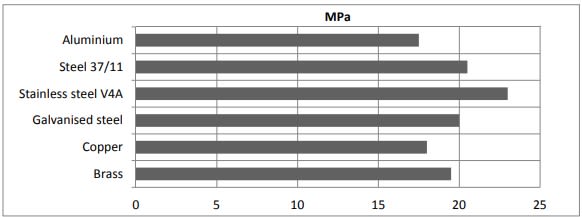
Average lap shear strengths of typical plastic-to-plastic joints (ISO 4587) (typical average values)
Cured for 16 hours at 40°C and tested at 23°C. Pretreatment - Lightly abrade and alcohol degrease.
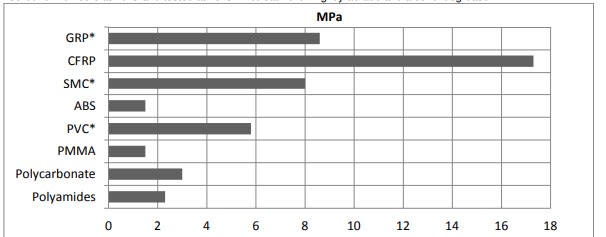
Lap shear strength versus temperature (ISO 4587) (typical average values)
On aluminium. Pretreatment: sandblasting. Cure: 16 hours at 40°C or 1 hour at 80°C
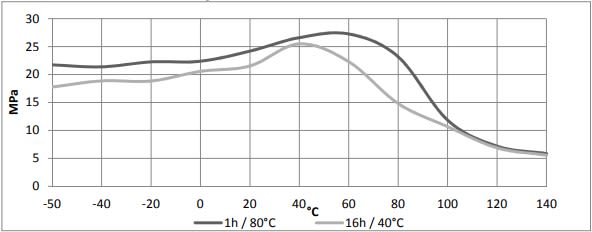
Glass transition temperature (typical average values)
Cure: 16 hours at 40°C (DMA)
Cure: 24 hours at 23°C + 1 hour at 80°C (DSC) ca. 69°C ca. 85°C
DMA (ISO 6721) (typical average values) Cure: 16 hours / 40°C
Temperature (°C)
G' 50°C 1.2 GPa 75°C 32 MPa 100°C 25 MPa 125°C 22 MPa Flexural Properties (ISO 178) (typical average values)
Cure: 16 hours / 40ºC and test at 23°C
Flexural Strength 60 MPa
Flexural Modulus 3500 MPa
Tensile Properties (ISO 527) (typical average values)
Cure: 16 hours / 40ºC and test at 23°C
Tensile Strength 30 MPa
Tensile Modulus 3100 MPa
Elongation at break 0.9 %
Property Test Value Unit Test Method Dielectric strength 25 kV/mm ASTM D-149 Surface resistivity 4.6 E+16 Ohm IEC 60093 Volume resistivity 2.7 E+15 Ohm.cm IEC 60093 Dielectric constant at 60Hz 4 IEC 60250 Loss tangent, % at 60Hz 1.3 % IEC 60250 Lap shear strength versus immersion in various media (typical average values)
On aluminium. Cured for 16 hours at 40°C and tested at 23°C. Pretreatment - Sand blasting
Unless otherwise stated, L.S.S. was determined after immersion for 30, 60 and 90 days at 23°C
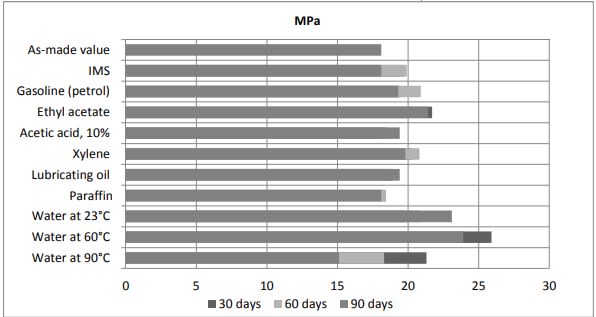
Lap shear strength versus tropical weathering (typical average values)
(40°C / 92% Relative Humidity) On aluminium. Cured for 16 hours at 40°C and tested at 23°C. Pretreatment - Sand blasting

Lap shear strength versus heat ageing (typical average values)
On aluminium. Cured for 16 hours at 40°C and tested at 23°C. Pretreatment - Sand blasting

- Typical Cured Properties
- Unless otherwise stated, the figures given below were all determined by testing standard specimens made by lapjointing 114 x 25 x 1.6 mm strips of aluminium alloy.
- The joint area was 12.5 x 25 mm in each case.
- The figures were determined with typical production batches using standard testing methods.
- They are provided solely as technical information and do not constitute a product specification.
Average lap shear strengths of typical metal-to-metal joints (ISO 4587) (typical average values)
Cured for 16 hours at 40°C, tested at 23°C. Pretreatment - Sand blasting and degreasing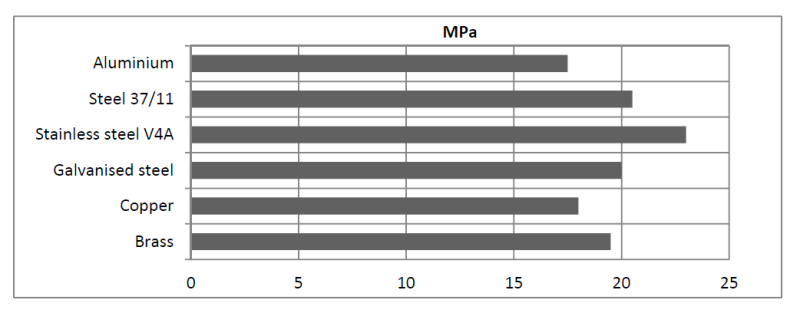
Average lap shear strengths of typical plastic-to-plastic joints (ISO 4587) (typical average values)
Cured for 16 hours at 40°C and tested at 23°C. Pretreatment - Lightly abrade and alcohol degrease.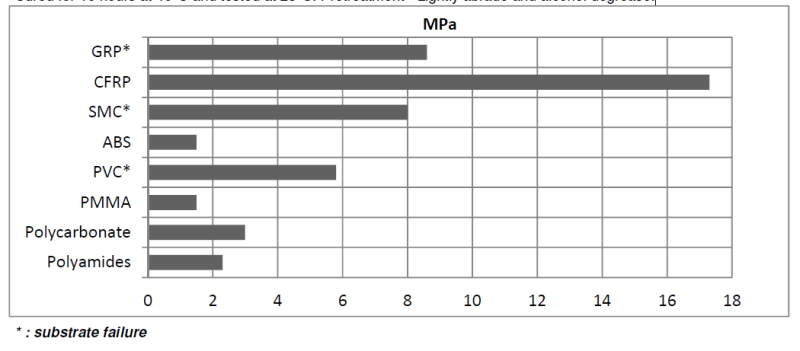
Lap shear strength versus temperature (ISO 4587) (typical average values)
On aluminium. Pretreatment: sandblasting. Cure: 16 hours at 40°C or 1 hour at 80°C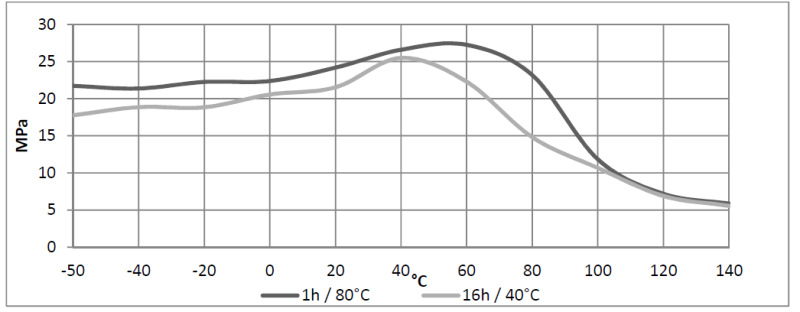
Glass transition temperature (typical average values)
Cure: 16 hours at 40°C (DMA) - ca. 69°CCure: 24 hours at 23°C + 1 hour at 80°C (DSC) - ca. 85°C
DMA (ISO 6721) (typical average values)
Cure: 16 hours / 40°CTemperature G' 50°C 1.2 GPa 75°C 32 MPa 100°C 25 MPa 125°C 22 MPa Flexural Properties (ISO 178) (typical average values)
Cure: 16 hours / 40ºC and test at 23°C
Flexural Strength - 60 MPa
Flexural Modulus - 3500 MPaTensile Properties (ISO 527) (typical average values)
Cure: 16 hours / 40ºC and test at 23°C
Tensile Strength - 30 MPa
Tensile Modulus - 3100 MPa
Elongation at break - 0.9 %Additional electrical properties (typical average values) Test values Test methods Dielectric strength (kV/mm) 25 ASTM D-149 Surface resistivity (Ohm) 4.6 E+16 IEC 60093 Volume resistivity (Ohm.cm) 2.7 E+15 IEC 60093 Dielectric constant at 60Hz 4.0 IEC 60250 Loss tangent, % at 60Hz 1.3 IEC 60250 Lap shear strength versus immersion in various media (typical average values)
On aluminium. Cured for 16 hours at 40°C and tested at 23°C. Pretreatment - Sand blasting
Unless otherwise stated, L.S.S. was determined after immersion for 30, 60 and 90 days at 23°C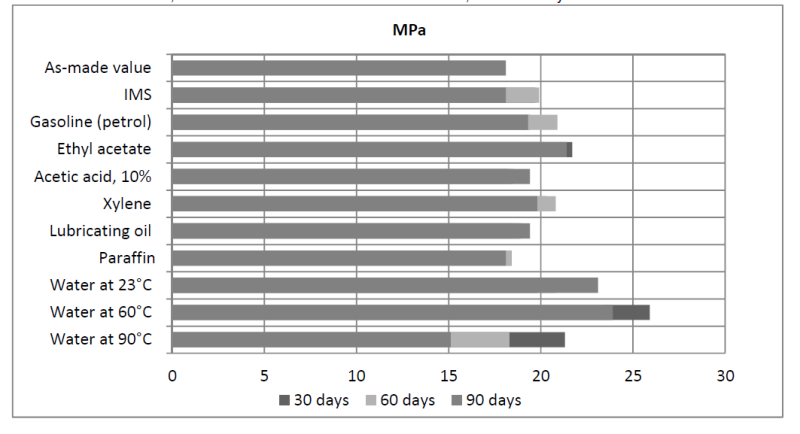
Lap shear strength versus tropical weathering (typical average values)
(40°C / 92% Relative Humidity) On aluminium. Cured for 16 hours at 40°C and tested at 23°C. Pretreatment - Sand
blasting
Lap shear strength versus heat ageing (typical average values)
On aluminium. Cured for 16 hours at 40°C and tested at 23°C. Pretreatment - Sand blasting

Safety & Health
- Handling Precautions
Caution : Our products are generally quite harmless to handle provided that certain precautions normally taken when handling chemicals are observed. The uncured materials must not, for instance, be allowed to come into contact with foodstuffs or food utensils, and measures should be taken to prevent the uncured materials from coming in contact with the skin, since people with particularly sensitive skin may be affected. The wearing of impervious rubber or plastic gloves will normally be necessary; likewise the use of eye protection. The skin should be thoroughly cleansed at the end of each working period by washing with soap and warm water. The use of solvents is to be avoided. Disposable paper - not cloth towels - should be used to dry the skin. Adequate ventilation of the working area is recommended.
Packaging & Availability
- Regional Availability
- Packaging Information
ARALDITE® 2014-2 is available in cartridges incorporating mixers and can be applied as ready to use adhesive with the aid of the tool recommended by Huntsman Advanced Materials.
Storage & Handling
- Storage Information
- ARALDITE® 2014-2 A/B must be stored at room temperature provided the components are stored in sealed containers.
- The expiry date is indicated on the label.
- Storage Conditions
ARALDITE® 2014-2 A/B must be stored at room temperature provided the components are stored in sealed containers. The expiry date is indicated on the label.
- Handling Information
- Our products are generally quite harmless to handle provided that certain precautions normally taken when handling chemicals are observed.
- The uncured materials must not, for instance, be allowed to come into contact with foodstuffs or food utensils, and measures should be taken to prevent the uncured materials from coming in contact with the skin, since people with particularly sensitive skin may be affected.
- The wearing of impervious rubber or plastic gloves will normally be necessary; likewise the use of eye protection.
- The skin should be thoroughly cleansed at the end of each working period by washing with soap and warm water.
- The use of solvents is to be avoided. Disposable paper - not cloth towels - should be used to dry the skin.
- Adequate ventilation of the working area is recommended.
Other
- Appearance
- Grey paste
- Application Information
Value Units Test Method / Conditions Mix Ratio 0.5 %(W) %(W) Hardener : Resin - Physical Properties
Value Units Test Method / Conditions Lap Shear Strength min. 14.0 MPa MPa Internal Method at 25°C Specific Gravity approx. 1.6 -
